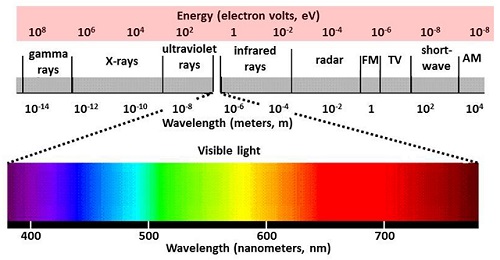Radiation
Electromagnetic radiation has both particle and wave properties. This is true for radioactive gamma radiation, x-rays, UV-radiation, visible light, radar and wavelenghts for communication (TV, radio, mobile phone, WLAN, Bluetooth etc.)
Historical reasons caused the daily use of the parameter wave lenghts (λ) or frequency (f). The relationship between both parameters is given by c = λ · f with c = speed of light. Important is as well that the energy increases with a decrease of the wave lenght and increase of the frequency.

Important is the fact that radiation such as radar and radio pervades solid material considerable well while this is not possible for visible light. On contray x-ray and gamma radiation is known as radiation which can pervade solids rather well. This is due to quanten-mechanical aspects of sorption on solids. With respect to radioactive gamma-radiation one has to consider additional beta- and alpha-radiation.
The natural occuring noble gas radon leads to a considerable exposure of humans (~50%) with readioactive radiation. The radon concentration depends on the regional geology and is higher by orders of magnitude in soil gas in comparison to the atmosphere. Indoor radon concentrations are elevated as well and the concentration depends on geology, construction materials and ventilation of the building. WHO recommends 100 Bq/m3 as maximum value while the EU put this value to 300 Bq/m3. More information can be taken from the WHO radon handbook.
Elektromagnetische Strahlung besitzt sowohl Teilchen- als auch Welleneigenschaften. Dies gilt für radioaktive Gamma-Strahlung, Röntgenstrahlung, UV-Strahlung, sichtbares Licht, Radar und Wellenlängen im Bereich der Kommunkation (TV, Radio, Funktelefon, WLAN, Bluetooth etc.).
Die Nutzung des Begriffs Wellenlänge (λ) oder Frequenz (f) in der praktischen Anwendung ist historisch bedingt und durch den Zusamenhang c = λ · f gegeben (c = Lichtgeschwindigkeit). Wichtig ist in dem Zusammenhang auch die Zunahme der Energie mit Abnahme der Wellenlänge (bzw. Zunahme der Frequenz).

Interessant ist der Aspekt, dass Strahlung im Bereich von Radar und "Radiowellen" Feststoffe vergleichsweise gut durchstrahlen können, während dies für sichtbares Licht nicht gegeben ist. Demgegenüber sind bekanntlich Röntgen- und Gammastrahlen durchaus in der Lage bestimmte Festsubstanzen zu durchstrahlen. Dies ist quantenmechanischen Aspekten der Sorption in Feststoffen geschuldet. Für den Bereich der radioaktiven Gamma-Strahlung muss zusätzlich die Beta- und Alphastrahlung betrachtet werden.
Eine nicht unerhebliche Belastung des Menschen (~50%) erfolgt über das natürliche Edelgas Radon. Die Konzentration ist abhängig von der Geologie und ist in der Bodenluft daher um Größenordnungen höher als in der Atmosphäre. In Gebäuden ist der Radongehalt gegenüber der Aussenluft erhöht und abhängig von der Geologie, Baumaterialien und der Lüftung des Gebäudes. Während die WHO 100 Bq/m3 als Maximalwert angibt, liegt dieser Grenzwert seitens der EU bei 300 Bq/m3. Interessierte finden im Radon Handbuch des Bundesamtes für Strahlenschutz weitere Informationen.
